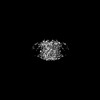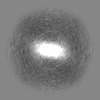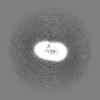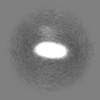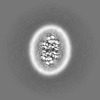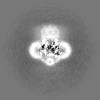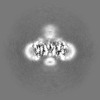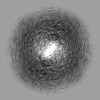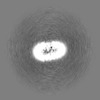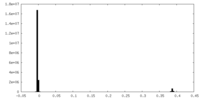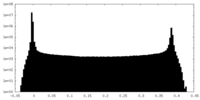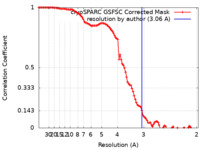+ Open data
Open data
- Basic information
Basic information
| Entry |  | |||||||||
|---|---|---|---|---|---|---|---|---|---|---|
| Title | Cryo-EM structure of horse Nhe9 bound to PI(3,5)P2 | |||||||||
 Map data Map data | ||||||||||
 Sample Sample |
| |||||||||
 Keywords Keywords | Na+/H+ exchanger / membrane protein / SLC9A9 / ion transporter / PI(3 / 5)P2 / TRANSPORT PROTEIN | |||||||||
| Function / homology |  Function and homology information Function and homology informationphagosome maturation / potassium:proton antiporter activity / sodium:proton antiporter activity / early phagosome / sodium ion import across plasma membrane / potassium ion transmembrane transport / sodium ion transmembrane transport / proton transmembrane transport / regulation of intracellular pH / recycling endosome ...phagosome maturation / potassium:proton antiporter activity / sodium:proton antiporter activity / early phagosome / sodium ion import across plasma membrane / potassium ion transmembrane transport / sodium ion transmembrane transport / proton transmembrane transport / regulation of intracellular pH / recycling endosome / recycling endosome membrane / phagocytic vesicle membrane / late endosome membrane / early endosome membrane / defense response to bacterium / protein homodimerization activity / plasma membrane Similarity search - Function | |||||||||
| Biological species |  | |||||||||
| Method | single particle reconstruction / cryo EM / Resolution: 3.06 Å | |||||||||
 Authors Authors | Kokane S / Meier P / Gulati A / Delemotte L / Drew D | |||||||||
| Funding support | European Union, 1 items
| |||||||||
 Citation Citation |  Journal: Nat Commun / Year: 2025 Journal: Nat Commun / Year: 2025Title: PIP-mediated oligomerization of the endosomal sodium/proton exchanger NHE9. Authors: Surabhi Kokane / Ashutosh Gulati / Pascal F Meier / Rei Matsuoka / Tanadet Pipatpolkai / Giuseppe Albano / Tin Manh Ho / Lucie Delemotte / Daniel Fuster / David Drew /   Abstract: The strict exchange of Na for H ions across cell membranes is a reaction carried out in almost every cell. Na/H exchangers that perform this task are physiological homodimers, and whilst the ion ...The strict exchange of Na for H ions across cell membranes is a reaction carried out in almost every cell. Na/H exchangers that perform this task are physiological homodimers, and whilst the ion transporting domain is highly conserved, their dimerization differs. The Na/H exchanger NhaA from Escherichia coli has a weak dimerization interface mediated by a β-hairpin domain and with dimer retention dependent on cardiolipin. Similarly, organellar Na/H exchangers NHE6, NHE7 and NHE9 also contain β-hairpin domains and recent analysis of Equus caballus NHE9 indicated PIP lipids could bind at the dimer interface. However, structural validation of the predicted lipid-mediated oligomerization has been lacking. Here, we report cryo-EM structures of E. coli NhaA and E. caballus NHE9 in complex with cardiolipin and phosphatidylinositol-3,5-bisphosphate PI(3,5)P lipids binding at their respective dimer interfaces. We further show how the endosomal specific PI(3,5)P lipid stabilizes the NHE9 homodimer and enhances transport activity. Indeed, we show that NHE9 is active in endosomes, but not at the plasma membrane where the PI(3,5)P lipid is absent. Thus, specific lipids can regulate Na/H exchange activity by stabilizing dimerization in response to either cell specific cues or upon trafficking to their correct membrane location. | |||||||||
| History |
|
- Structure visualization
Structure visualization
| Supplemental images |
|---|
- Downloads & links
Downloads & links
-EMDB archive
| Map data |  emd_17971.map.gz emd_17971.map.gz | 50.8 MB |  EMDB map data format EMDB map data format | |
|---|---|---|---|---|
| Header (meta data) |  emd-17971-v30.xml emd-17971-v30.xml emd-17971.xml emd-17971.xml | 16.4 KB 16.4 KB | Display Display |  EMDB header EMDB header |
| FSC (resolution estimation) |  emd_17971_fsc.xml emd_17971_fsc.xml | 9.9 KB | Display |  FSC data file FSC data file |
| Images |  emd_17971.png emd_17971.png | 112.2 KB | ||
| Masks |  emd_17971_msk_1.map emd_17971_msk_1.map | 103 MB |  Mask map Mask map | |
| Filedesc metadata |  emd-17971.cif.gz emd-17971.cif.gz | 6.2 KB | ||
| Others |  emd_17971_half_map_1.map.gz emd_17971_half_map_1.map.gz emd_17971_half_map_2.map.gz emd_17971_half_map_2.map.gz | 95.4 MB 95.4 MB | ||
| Archive directory |  http://ftp.pdbj.org/pub/emdb/structures/EMD-17971 http://ftp.pdbj.org/pub/emdb/structures/EMD-17971 ftp://ftp.pdbj.org/pub/emdb/structures/EMD-17971 ftp://ftp.pdbj.org/pub/emdb/structures/EMD-17971 | HTTPS FTP |
-Validation report
| Summary document |  emd_17971_validation.pdf.gz emd_17971_validation.pdf.gz | 834.9 KB | Display |  EMDB validaton report EMDB validaton report |
|---|---|---|---|---|
| Full document |  emd_17971_full_validation.pdf.gz emd_17971_full_validation.pdf.gz | 834.5 KB | Display | |
| Data in XML |  emd_17971_validation.xml.gz emd_17971_validation.xml.gz | 18.3 KB | Display | |
| Data in CIF |  emd_17971_validation.cif.gz emd_17971_validation.cif.gz | 23.8 KB | Display | |
| Arichive directory |  https://ftp.pdbj.org/pub/emdb/validation_reports/EMD-17971 https://ftp.pdbj.org/pub/emdb/validation_reports/EMD-17971 ftp://ftp.pdbj.org/pub/emdb/validation_reports/EMD-17971 ftp://ftp.pdbj.org/pub/emdb/validation_reports/EMD-17971 | HTTPS FTP |
-Related structure data
| Related structure data | 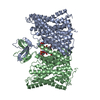 8pvrMC 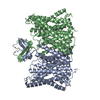 8pxbC M: atomic model generated by this map C: citing same article ( |
|---|---|
| Similar structure data | Similarity search - Function & homology  F&H Search F&H Search |
- Links
Links
| EMDB pages |  EMDB (EBI/PDBe) / EMDB (EBI/PDBe) /  EMDataResource EMDataResource |
|---|
- Map
Map
| File |  Download / File: emd_17971.map.gz / Format: CCP4 / Size: 103 MB / Type: IMAGE STORED AS FLOATING POINT NUMBER (4 BYTES) Download / File: emd_17971.map.gz / Format: CCP4 / Size: 103 MB / Type: IMAGE STORED AS FLOATING POINT NUMBER (4 BYTES) | ||||||||||||||||||||||||||||||||||||
|---|---|---|---|---|---|---|---|---|---|---|---|---|---|---|---|---|---|---|---|---|---|---|---|---|---|---|---|---|---|---|---|---|---|---|---|---|---|
| Projections & slices | Image control
Images are generated by Spider. | ||||||||||||||||||||||||||||||||||||
| Voxel size | X=Y=Z: 0.9746 Å | ||||||||||||||||||||||||||||||||||||
| Density |
| ||||||||||||||||||||||||||||||||||||
| Symmetry | Space group: 1 | ||||||||||||||||||||||||||||||||||||
| Details | EMDB XML:
|
-Supplemental data
-Mask #1
| File |  emd_17971_msk_1.map emd_17971_msk_1.map | ||||||||||||
|---|---|---|---|---|---|---|---|---|---|---|---|---|---|
| Projections & Slices |
| ||||||||||||
| Density Histograms |
-Half map: #2
| File | emd_17971_half_map_1.map | ||||||||||||
|---|---|---|---|---|---|---|---|---|---|---|---|---|---|
| Projections & Slices |
| ||||||||||||
| Density Histograms |
-Half map: #1
| File | emd_17971_half_map_2.map | ||||||||||||
|---|---|---|---|---|---|---|---|---|---|---|---|---|---|
| Projections & Slices |
| ||||||||||||
| Density Histograms |
- Sample components
Sample components
-Entire : Dimeric Horse Nhe9 with PI(3,5)P2
| Entire | Name: Dimeric Horse Nhe9 with PI(3,5)P2 |
|---|---|
| Components |
|
-Supramolecule #1: Dimeric Horse Nhe9 with PI(3,5)P2
| Supramolecule | Name: Dimeric Horse Nhe9 with PI(3,5)P2 / type: complex / ID: 1 / Parent: 0 / Macromolecule list: #1 |
|---|---|
| Source (natural) | Organism:  |
| Molecular weight | Theoretical: 64 KDa |
-Macromolecule #1: Sodium/hydrogen exchanger 9
| Macromolecule | Name: Sodium/hydrogen exchanger 9 / type: protein_or_peptide / ID: 1 / Number of copies: 2 / Enantiomer: LEVO |
|---|---|
| Source (natural) | Organism:  |
| Molecular weight | Theoretical: 64.856055 KDa |
| Recombinant expression | Organism:  |
| Sequence | String: MSEKDEYQFQ HQGAVELLVF NFLLILTILT IWLFKNHRFR FLHETGGAMV YGLIMGLILR YATAPTDIES GTVYDCGKLA FSPSTLLIN ITDQVYEYKY KREISQHNIN PHLGNAILEK MTFDPEIFFN VLCPPIIFHA GYSLKKRHFF QNLGSILTYA F LGTAISCI ...String: MSEKDEYQFQ HQGAVELLVF NFLLILTILT IWLFKNHRFR FLHETGGAMV YGLIMGLILR YATAPTDIES GTVYDCGKLA FSPSTLLIN ITDQVYEYKY KREISQHNIN PHLGNAILEK MTFDPEIFFN VLCPPIIFHA GYSLKKRHFF QNLGSILTYA F LGTAISCI VIGLIMYGFV KAMVYAGQLK NGDFHFTDCL FFGSLMSATD PVTVLAIFHE LHVDPDLYTL LFGESVLNDA VA IVLTYSI SIYSPKENPN AFDAAAFFQS VGNFLGIFAG SFAMGSAYAV VTALLTKFTK LCEFPMLETG LFFLLSWSAF LSA EAAGLT GIVAVLFCGV TQAHYTYNNL SLDSKMRTKQ LFEFMNFLAE NVIFCYMGLA LFTFQNHIFN ALFILGAFLA IFVA RACNI YPLSFLLNLG RKHKIPWNFQ HMMMFSGLRG ACAFALAIRD TESQPKQMMF STTLLLVFFT VWVFGGGTTP MLTWL QIRV GVDLDEDLKE RPSSHQEANN LEKSTTKTES AWLFRMWYGF DHKYLKPILT HSGPPLTTTL PEWCGPISRL LTSPQA YGE QLKEGENLYF Q UniProtKB: Sodium/hydrogen exchanger 9 |
-Macromolecule #2: (2R)-3-{[(S)-hydroxy{[(1S,2R,3R,4S,5S,6R)-2,4,6-trihydroxy-3,5-bi...
| Macromolecule | Name: (2R)-3-{[(S)-hydroxy{[(1S,2R,3R,4S,5S,6R)-2,4,6-trihydroxy-3,5-bis(phosphonooxy)cyclohexyl]oxy}phosphoryl]oxy}propane-1,2-diyl dioctanoate type: ligand / ID: 2 / Number of copies: 2 / Formula: EUJ |
|---|---|
| Molecular weight | Theoretical: 746.566 Da |
| Chemical component information | 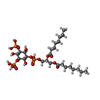 ChemComp-EUJ: |
-Experimental details
-Structure determination
| Method | cryo EM |
|---|---|
 Processing Processing | single particle reconstruction |
| Aggregation state | particle |
- Sample preparation
Sample preparation
| Buffer | pH: 8 |
|---|---|
| Vitrification | Cryogen name: ETHANE |
- Electron microscopy
Electron microscopy
| Microscope | FEI TITAN KRIOS |
|---|---|
| Image recording | Film or detector model: GATAN K3 BIOQUANTUM (6k x 4k) / Average electron dose: 68.5 e/Å2 |
| Electron beam | Acceleration voltage: 300 kV / Electron source:  FIELD EMISSION GUN FIELD EMISSION GUN |
| Electron optics | Illumination mode: FLOOD BEAM / Imaging mode: BRIGHT FIELD / Nominal defocus max: 2.0 µm / Nominal defocus min: 0.4 µm |
| Experimental equipment |  Model: Titan Krios / Image courtesy: FEI Company |
 Movie
Movie Controller
Controller





 Z (Sec.)
Z (Sec.) Y (Row.)
Y (Row.) X (Col.)
X (Col.)
